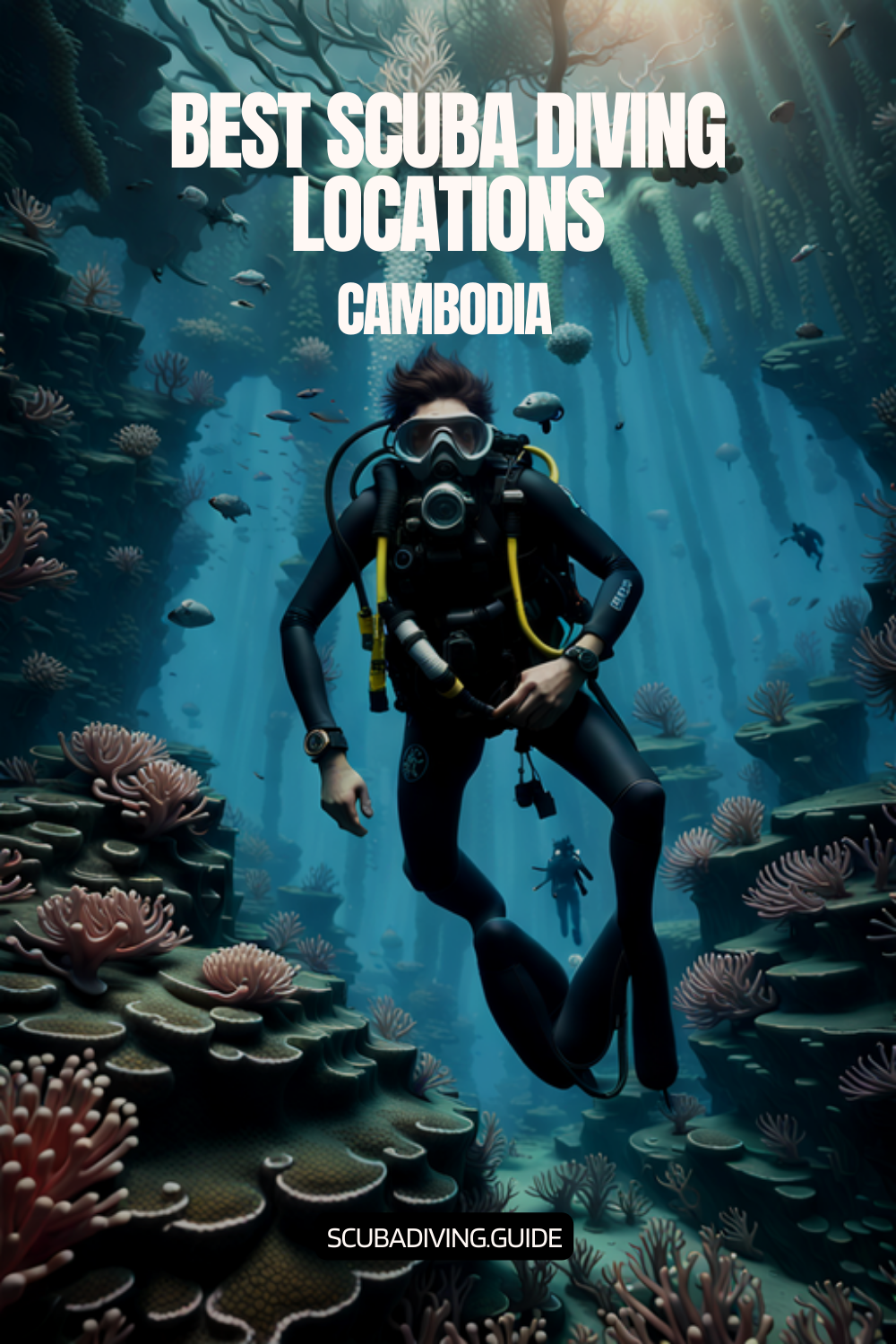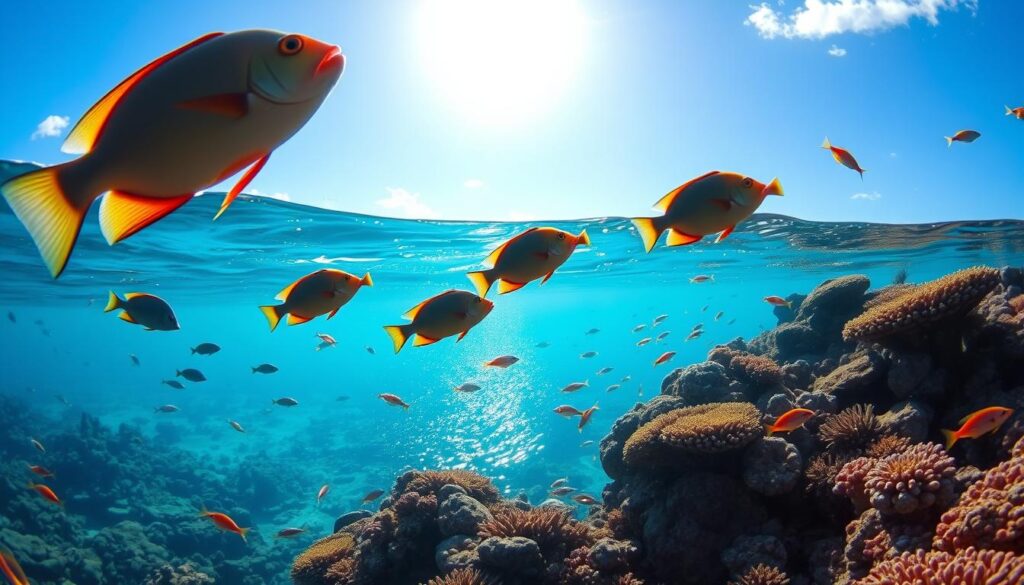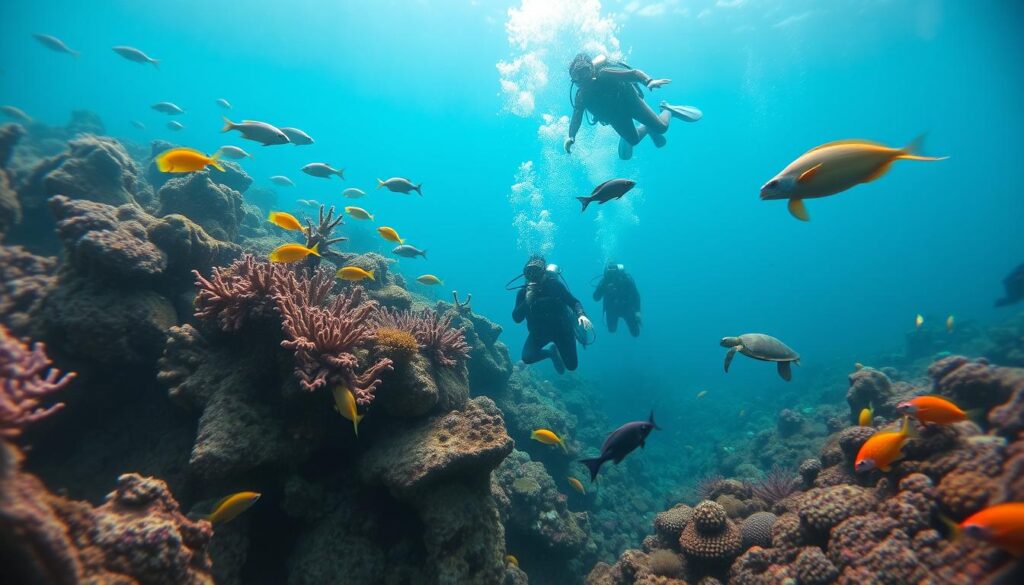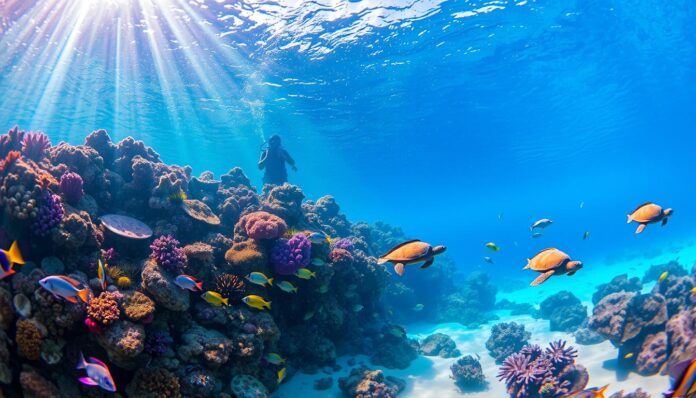| Best Time to Travel | November to May |
| What to Expect | Warm water, clear visibility, diverse marine life |
| Diving Conditions | Year-round, but best from November to May |
| Marine Life | Sharks, turtles, rays, fish, coral |
Are you ready to explore an underwater world that few divers have experienced? Cambodia offers a hidden marine paradise. It challenges everything you thought you knew about tropical diving destinations.
Scuba diving in Cambodia reveals a mesmerizing underwater landscape. It remains largely undiscovered by mainstream diving communities. The coastal regions, like Sihanoukville and the surrounding islands, offer an extraordinary opportunity for underwater adventurers.
Cambodian marine life thrives in crystal-clear waters. This gives divers an immersive experience across diverse dive sites. From vibrant coral reefs to unique marine species, each underwater location promises an unforgettable journey into the depths of Southeast Asian marine biodiversity.
Key Takeaways – Scuba Diving in Cambodia
- Cambodia offers unique and unexplored scuba diving experiences
- Multiple dive sites cater to different skill levels
- Rich marine biodiversity with rare species encounters
- Affordable diving compared to other Southeast Asian destinations
- Pristine underwater landscapes await discovery

Why Choose Cambodia for Scuba Diving?
Cambodia is a top spot for scuba diving, drawing divers from everywhere. Its underwater world is full of life and easy to get to. You’ll find amazing dive sites and a rich variety of marine life.
Beautiful Cambodian Marine Life
The underwater world in Cambodia is stunning, filled with colorful ecosystems. You can dive among coral reefs, home to many marine species. Scientists have found:
- Over 150 species of hard corals
- More than 400 fish species
- Diverse marine inhabitants including parrotfish, butterflyfish, and angelfish
Diverse Underwater Ecosystems
Cambodia’s seas offer a wide range of diving experiences. You can dive in shallow reefs or deeper waters. Each place has its own unique underwater world.
| Dive Site | Visibility | Water Temperature |
|---|---|---|
| Koh Tang | 20-30 meters | 27-30°C |
| Koh Rong Samloem | 10-20 meters | 26-29°C |
Accessibility and Affordability
Diving in Cambodia is both affordable and easy to get to. Dive packages cost between 60-600 USD. It’s a great choice for both new and seasoned divers.
“Cambodia offers world-class diving experiences at budget-friendly prices” – Diving Enthuasiast Magazine
With over 443 kilometers of coastline, Cambodia has many places to dive. It’s perfect for memorable underwater adventures, no matter your skill level.
Top Scuba Diving Spots in Cambodia
Cambodia is a paradise for scuba diving, with many islands to explore. Each island offers unique marine experiences. Divers can see vibrant ecosystems and meet incredible sea creatures.
Koh Rong Samloem: A Diving Haven
Koh Rong Samloem is a top spot for diving. It’s just a 40-minute speedboat ride from Sihanoukville. The island has great dive sites for all skill levels.
- Secret Garden dive site
- Cobia Point
- Rocky Bay
- Nudibranch Heaven
Divers can see amazing marine life, including:
- Horned seastars
- Seahorses
- Colorful nudibranchs
Koh Tang: Advanced Diving Exploration
Koh Tang is perfect for those who love wreck diving. The island has dive sites for all, from beginners to experts.
Some notable sites are:
- Explosion Reef
- Three Bears
- Sting Ray Alley
“Koh Tang offers an unparalleled diving experience with its diverse marine ecosystem and stunning underwater terrain.”
Rabbit Island: Hidden Underwater Gem
Rabbit Island is a hidden gem for diving. Its shallow waters and vibrant life are great for exploration and macro photography.
Water temperatures are between 27-31°C (80-88°F). This makes for a memorable diving trip in Cambodia’s clear waters.
What to Expect While Diving in Cambodia
Scuba diving in Cambodia is an amazing adventure. You’ll see clear waters, unique marine life, and it’s affordable. Divers get to explore some of Southeast Asia’s most interesting dive sites.
Clear Waters and Marine Visibility
When diving in Cambodia, knowing the water conditions is key. Visibility is usually 5 to 20 meters. This gives divers a great view underwater. Experienced divers say the best times to dive are during the optimal seasons.
- Average visibility: 5-10 meters (75% of dive time)
- Peak visibility: Up to 20-30 meters at specific locations
- Best visibility months: December to April
Warm Water Temperatures
Cambodia’s tropical waters are perfect for diving. The water temperature is between 79°F and 86°F all year. This makes diving very comfortable.
| Season | Water Temperature | Diving Comfort |
|---|---|---|
| Dry Season | 82-86°F | Excellent |
| Wet Season | 79-82°F | Very Good |
Unique Dive Experiences
Snorkeling and scuba diving in Cambodia are special. You’ll see rare marine species like seahorses and nudibranchs. You might even see the Indian Walkman (Devil Stinger).
“The underwater world of Cambodia presents a hidden treasure trove of marine biodiversity.” – Marine Conservation Expert
- Dive trip costs: $75 USD for a two-dive day
- Overnight trips: $165 USD for four dives
- Unique marine species spotting
- Optional night dive experiences
Scuba diving in Cambodia is both challenging and rewarding. With less marine debris and more fish, diving here is getting better. It’s becoming a top spot for underwater adventures.
Best Time to Go Scuba Diving in Cambodia
Planning a scuba diving trip in Cambodia needs careful thought about the seasons. The tropical weather offers great chances to explore underwater all year. But, some times are better than others for diving fans.

The dry season, from November to May, is the best time for diving in Cambodia. During this time, the waters are clear, and you can see far underwater.
Weather Conditions for Diving
The diving scene in Cambodia changes with the seasons. This affects what you see and experience underwater:
- Water temperatures stay between 27°C to 29°C
- Visibility can be from 10 to 40 meters, depending on where you dive
- Afternoon rain is common in the wet seasons
Diving Season Overview
Here’s what you can expect during different months:
| Period | Diving Conditions | Recommended Skill Level |
|---|---|---|
| November-May | Excellent visibility, calm waters | All skill levels |
| January-April | Peak diving season | Intermediate to Advanced |
| July-September | Limited diving opportunities | Advanced divers |
Regional Variations
Diving in Cambodia offers different experiences in various places. Key spots include Koh Rong, Koh Rong Samloem, Koh Tang, and Koh Totang. Each place has its own underwater world and marine life.
“The magic of Cambodian waters lies in their unpredictability and rich marine biodiversity.” – Professional Diving Instructor
For the best diving in Cambodia, plan your trip from November to May. This way, you’ll get the most out of your underwater adventures and enjoy the best marine conditions.
Necessary Diving Certifications in Cambodia
Cambodia is a great place for diving, with many certification options. Whether you’re new or have lots of diving experience, there’s a program for you. These programs help you explore the beautiful underwater world of Southeast Asia.
In Cambodia, you can find diving courses for all levels. From beginner to advanced, there’s a path for everyone. These paths aim to improve your diving skills and keep you safe underwater.
Entry-Level Certifications
Newcomers to scuba diving have several options in Cambodia:
- PADI Scuba Diver Course (2-day program)
- Maximum diving depth of 12 meters with instructor supervision
- Minimum participant age: 10 years old
- Junior Open Water Diver certification for participants under 15
Advanced Certifications
For those with more diving experience, there are advanced courses:
| Course | Key Features |
|---|---|
| Advanced Open Water Diver | Multiple dive experience, skill enhancement |
| Enriched Air Nitrox | Certification for diving with up to 40% oxygen levels |
| Rescue Diver | Includes first aid and CPR training |
Specialty Courses Available
Cambodia’s dive centers also offer special courses for the adventurous:
- Underwater Navigation
- Drift Diving
- Search and Recovery
- Underwater Photography
“Diving is not just about exploring underwater worlds, but also about continuous learning and skill development.” – Professional Dive Instructor
Dive Certifications in Cambodia focus on safety and thorough training. Before starting, you must pass a medical check and show you can swim.
Popular Dive Operators in Cambodia
Scuba diving in Cambodia is a unique underwater adventure. Several top-notch dive operators make it special. The marine landscape is perfect for exploring vibrant ecosystems and finding hidden treasures.
Dive Resorts Cambodia have a few professional operators. They offer top services for both new and experienced divers.
Scuba Nation: A Pioneer in Cambodian Diving
Scuba Nation started in 2002 and is a key player in Cambodia’s diving scene. It’s the first PADI 5 Star Instructor Development Centre here. They cater to tourists, expats, embassy staff, and locals.
- Tourists seeking underwater adventures
- Expatriate communities
- Embassy personnel
- Local diving enthusiasts
They are known for their quality. They have:
- A student-to-instructor ratio of 4:1
- Won the PADI Outstanding Contribution to Dive Industry award three times
- Offer daily diving trips and liveaboard expeditions
- Provide diving services in multiple languages
The Dive Shop Cambodia
The Dive Shop is another top operator. They offer full diving experiences in Cambodia’s underwater world.
EcoSea Dive
EcoSea Dive is the third top operator. They focus on sustainable and educational diving in Cambodia’s marine environments.
“Cambodia’s dive operators offer more than just underwater exploration—they provide gateways to marine discovery and conservation.”
For those interested in Scuba Diving in Cambodia, these operators ensure safe and memorable experiences. They cover the country’s stunning dive sites.
Preparing for Your Scuba Diving Trip
Scuba diving in Cambodia needs careful planning for a safe and fun dive. Knowing the right gear, how to pack, and health tips will enhance your diving experience.
Essential Gear Checklist
For scuba diving in Cambodia, the right equipment is key. Here’s a list of must-haves for divers:
- Personal diving mask
- Fins and snorkel
- Wetsuit for tropical waters
- Buoyancy Control Device (BCD)
- Diving regulator
- Dive computer
- Underwater camera (optional)
Packing Tips for Divers
Smart packing makes your diving trip in Cambodia better. Here are some tips:
- Pack lightweight, quick-dry clothes
- Bring waterproof sunscreen
- Carry spare diving parts
- Include a first-aid kit
Health and Safety Considerations
Health is a top priority for safe diving in Cambodia. Important points to remember include:
| Consideration | Recommendation |
|---|---|
| Medical Examination | Recommended for first-time divers |
| Depth Limit | Maximum 130 feet (40 meters) |
| Pre-Dive Health | Avoid diving if unwell |
| Flying After Diving | Wait 24 hours to allow nitrogen dissipation |
“Preparation is the key to an unforgettable underwater exploration in Cambodia’s beautiful marine environments.”
By following these guidelines, you’ll be well-prepared for an incredible scuba diving adventure in Cambodia’s stunning waters.
Marine Conservation Efforts in Cambodia
Cambodia’s underwater world is full of life and diversity. It faces big challenges, needing strong conservation efforts to keep it healthy.

Marine Conservation Cambodia (MCC) has led the fight to save the country’s seas. They focus on many areas to protect the ocean.
Importance of Biodiversity
The coasts of Cambodia are home to amazing ecosystems. Key highlights include:
- Largest seagrass meadows in the Gulf of Thailand
- Home to endangered marine species
- Critical habitats for marine mammals
“Conservation is not just about protecting marine life, but preserving entire ecosystems.” – Marine Conservation Cambodia
Local Initiatives
Many efforts are underway to protect Coral Reefs Cambodia and the sea around it:
- Establishment of Marine Fisheries Management Area (MFMA) in 2018
- Deployment of Conservation and Anti-Trawling Structures (CANTS)
- Seagrass restoration projects
| Conservation Metric | Achievement |
|---|---|
| Seagrass Restoration | Over 2,000 hectares regrown |
| Artificial Habitat Structures | 300+ deployed in Kep MFMA |
| Planned Coastal Structures | 5,000 structures planned |
How Divers Can Contribute
Divers are key in saving the sea. Ways to help include:
- Join underwater clean-up activities
- Support local marine conservation groups
- Follow responsible diving practices
- Help spread the word about protecting marine life
Every dive is a chance to help protect Cambodia’s marine world.
Scuba Diving and Cultural Experiences
Cambodia is a unique place for scuba diving. It has 443 km of coastline and 60 islands. These offer great chances to see marine life and learn about local traditions.
Diving in Cambodia is more than just seeing marine life. It’s about connecting the ocean with local culture. Underwater adventures and community practices come together here.
Engaging with Local Coastal Communities
Coastal communities in Cambodia are key to marine conservation. Divers can:
- Interact with local fishing villages
- Learn traditional maritime skills
- Support sustainable tourism
Traditional Marine Practices
Traditional fishing in Cambodia shows how to manage marine resources well. Angkor Wat Underwater expeditions highlight the bond between locals and the sea.
“The ocean is our life, our history, our future” – Local Cambodian Fisherman
Underwater Photography Opportunities
Cambodia is great for underwater photography, like around Koh Rong Samloem and Koh Tang. Photographers can take:
- Colorful coral formations
- Unique marine species
- Potential Angkor Wat underwater finds
| Diving Location | Unique Feature | Photography Opportunity |
|---|---|---|
| Koh Rong Samloem | Nudibranch Paradise | Macro Marine Life |
| Koh Tang | Clear Waters | Wide-Angle Seascapes |
| Koh Sdach | Diverse Ecosystem | Marine Habitat Shots |
Scuba diving in Cambodia is more than fun. It’s a chance to deeply explore the marine world and local culture.
Accommodations Near Dive Sites
Planning your Dive Resorts Cambodia adventure means picking the right place to stay. The coastal areas have many lodging choices for every diver’s taste and budget.
Luxury Dive Resorts
Cambodia’s dive spots have top-notch resorts for those wanting the best. Song Saa Private Island is a highlight with:
- 5-star luxury rating
- Exceptional guest rating of 9.60/10
- Prices starting at $839 per night
Mid-Range Accommodations
For those looking for good value, Cambodia has great options. Veranda Natural Resort offers:
- 4-star resort amenities
- Guest rating of 8.80/10
- Prices starting at $75 per night
Budget-Friendly Stays
For those watching their budget, there are many choices near great diving spots:
| Resort | Price Range | Guest Rating |
|---|---|---|
| Saracen Bay Resort | $88/night | 9.40/10 |
| Sok San Beach Resort | $61/night | 8.00/10 |
| Tanei Boutique Villa | $21/night | 7.80/10 |
Unique Diving Accommodations
Island PADI Dive Resort is a special place on Koh Rong Samloem Island. It’s close to a Marine Conservation and Research Center. This gives divers a chance to see and learn about marine life.
“Choose an accommodation that enhances your diving experience and connects you with Cambodia’s marine environment.”
When picking your Dive Resorts Cambodia, think about how close it is to dive sites, what amenities it has, and how comfortable it is. This will make your underwater adventure unforgettable.
Land Activities to Enjoy During Your Stay
Cambodia is full of exciting land activities that match your underwater adventures. Whether you love scuba diving or just enjoy traveling, the coastal areas have lots to offer. You can find fun experiences beyond the sea.
Island Hopping Adventures
Discover Cambodia’s beautiful islands on unforgettable tours. Snorkeling in Cambodia lets you see amazing landscapes and marine life. You can visit:
- 4-hour island tours to Koh Touch and Koh Koun
- Snorkeling at Dog Island with a picnic lunch at Lonely Beach
- Exploring hidden beaches and untouched shores
Snorkeling Excursions
Looking for Angkor Wat Underwater without scuba diving? Snorkeling is a great choice. Koh Rong has shallow reefs and calm waters. You can see:
- Snorkeling around jetty and rocky beach corners
- Diverse marine life like cuttlefish and seahorses
- Guided tours with all the safety gear
Cultural Excursions
There’s more to Cambodia than water activities. Explore its rich culture with:
- Mangrove kayaking tours on Ta Sok River
- Cycling through local villages
- Visiting traditional fishing communities
Pro tip: Many tour operators offer packages that mix water and land activities. They give great value to travelers looking for a variety of experiences.
Frequently Asked Questions About Diving in Cambodia
Scuba diving in Cambodia can raise many questions for first-time and experienced divers alike. Our guide addresses the most common concerns. It helps you prepare for an unforgettable underwater adventure.
Dos and Don’ts for Divers
Responsible diving is key to preserving Cambodia’s marine ecosystems. Here are essential guidelines for Scuba Diving in Cambodia:
- Do respect marine life and avoid touching coral or marine creatures
- Don’t remove anything from underwater environments
- Do follow your dive instructor’s guidance
- Don’t dive beyond your certification level
- Do check your equipment before each dive
- Don’t ignore safety protocols
Beginner Tips for Dive Certifications Cambodia
New divers should consider these important recommendations:
- Start with entry-level PADI certification courses
- Practice in controlled environments first
- Invest in proper dive insurance
- Take refresh courses if you haven’t dived recently
Emergency Contacts and Preparedness
Safety is key when exploring underwater environments. Here’s a quick reference for emergency preparedness:
| Contact Type | Details |
|---|---|
| Local Emergency Services | 112 (Cambodia’s national emergency number) |
| Hyperbaric Chamber | Phnom Penh International Hospital |
| Dive Insurance Hotline | DAN (Divers Alert Network) International |
“Preparation and knowledge are your best dive buddies in any underwater adventure.” – Professional Dive Instructor
Remember, Dive Certifications Cambodia require proper training and awareness. Always prioritize safety and respect for the marine environment during your underwater exploration.
Cambodia Recommended Scuba Diving Itinerary
To make the most of your scuba diving adventure in Cambodia, it’s helpful to have a well-planned itinerary that takes you to the best dive sites and ensures a diverse and rewarding experience. Here is a recommended diving itinerary that showcases the highlights of Cambodia’s underwater world:
Day 1: Arrive in Sihanoukville
Upon arrival in Sihanoukville, a coastal city known for its beautiful beaches and vibrant atmosphere, settle into your accommodation and explore the local surroundings. Take this day to acclimate to the area and prepare for your upcoming diving adventures.
Day 2-3: Dive in Koh Rong
Travel to the stunning island of Koh Rong, where you’ll begin your underwater explorations. Koh Rong offers a variety of dive sites suitable for divers of all levels. Dive among vibrant coral reefs, encounter colorful marine life, and discover the underwater wonders of this tropical paradise. Spend two days diving around Koh Rong, immersing yourself in its breathtaking underwater landscapes.
Day 4-5: Discover Koh Rong Samloem
Embark on a short boat ride to the neighboring island of Koh Rong Samloem, known for its picturesque beaches and pristine diving sites. Spend two days diving around Koh Rong Samloem, exploring its captivating underwater world. Marvel at the diverse marine ecosystems, swim alongside tropical fish, and perhaps even encounter larger marine species such as reef sharks and rays.
Day 6-7: Journey to Koh Tang
Set sail towards the remote island of Koh Tang, an off-the-beaten-path diving destination that promises exceptional diving experiences. Koh Tang is renowned for its crystal-clear waters, dramatic drop-offs, and abundant marine life. Dive into its depths and discover vibrant coral gardens, encounter schools of barracuda, and explore intriguing underwater caves and canyons. Spend two days exploring the unique underwater landscapes of Koh Tang.
Day 8-9: Dive in Koh Kon
Continue your diving adventure to Koh Kon, a hidden gem near the Thai border. Koh Kon offers exciting dive sites with impressive underwater topography, including swim-throughs, canyons, and caves. Explore the vibrant coral reefs, keep an eye out for whale sharks and manta rays, and immerse yourself in the beauty of this lesser-known dive destination. Enjoy two days diving around Koh Kon, uncovering its hidden treasures.
Day 10: Return to Sihanoukville
Bid farewell to the islands and return to Sihanoukville. Take this day to relax, reflect on your diving experiences, and explore the city’s local attractions and culinary delights. Sihanoukville offers a vibrant nightlife and a chance to immerse yourself in the local culture before concluding your diving adventure in Cambodia.
This recommended itinerary provides a balanced and diverse scuba diving experience in Cambodia, showcasing the best of the country’s underwater treasures. However, it’s important to note that weather conditions and availability of dive sites may vary, so it’s advisable to consult with local dive operators and adjust your itinerary accordingly.
By following this itinerary, you’ll have the opportunity to explore Cambodia’s most renowned dive sites, encounter fascinating marine life, and create unforgettable memories beneath the waves. So, get ready to dive into the wonders of Cambodia’s underwater world and embark on an incredible scuba diving journey.

Other Countries to Consider
Conclusion: Plan Your Scuba Diving Adventure in Cambodia
Scuba diving in Cambodia is an amazing journey. It combines adventure, natural beauty, and culture. You’ll see crystal-clear waters and diverse marine life, making it a unique experience.
Diving in Cambodia is affordable for all. Prices range from $35 to $100 USD per dive. This lets you explore top marine spots without spending too much. Dive operators like Scuba Nation offer quality training and memorable dives.
Dive into a Unique Destination
Your dive in Cambodia will be unforgettable. You’ll see vibrant marine life and stunning coral. Each dive opens a window to Cambodia’s marine world.
Your Next Great Adventure Awaits
Are you ready to dive into Cambodia? Start planning your trip now. Look for dive operators, check the weather, and get ready for an adventure. Cambodia’s underwater world is waiting for you.
FAQ – Scuba Diving in Cambodia
What certification do I need to scuba dive in Cambodia?
Beginners should get an Open Water Diver certification. Dive operators in Cambodia offer PADI or SSI courses. If you’re not certified, you can start a course at places like Koh Rong or Koh Tang.
Advanced divers can get specialty certifications. These include wreck diving or underwater photography.
What is the best time of year to go scuba diving in Cambodia?
The best time to dive in Cambodia is from November to April. This is the dry season with clear visibility (up to 30 meters) and calm seas. December to February is the peak, with the best conditions and marine life visibility.
How much does scuba diving cost in Cambodia?
Diving in Cambodia is affordable. Prices are $30 to $80 per dive, based on location and operator. Certification courses cost $350 to $500. Look for budget-friendly packages and discounts in places like Sihanoukville and Koh Rong.
What marine life can I expect to see while diving in Cambodia?
Cambodia’s waters are home to diverse marine life. You’ll see tropical fish like clownfish and angelfish. Seahorses, moray eels, and reef sharks are also common. Koh Tang offers chances to see larger species and vibrant coral reefs.
Is Cambodia safe for scuba diving?
Yes, Cambodia is safe for diving. Dive operators follow safety standards and provide good equipment. Always choose reputable centers, have insurance, follow safety rules, and get a medical check before diving.
Do I need to bring my own diving equipment?
Most operators provide equipment, but serious divers might bring their own. You can rent in Sihanoukville, Koh Rong, and other spots. Rental prices are $5 to $15 per item.
What are the water temperatures like in Cambodia?
Cambodia’s waters are warm, between 27°C to 30°C (80°F to 86°F) all year. This makes diving comfortable. Most divers prefer a 3mm wetsuit or just a rashguard.
Are there any conservation efforts I can participate in while diving?
Yes, many dive operators have marine conservation programs. You can help with coral reef restoration, underwater clean-ups, and marine life monitoring. Organizations like Marine Conservation Cambodia welcome diving enthusiasts to support local ecosystems.
